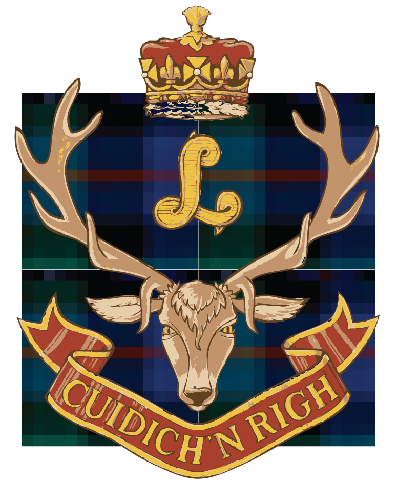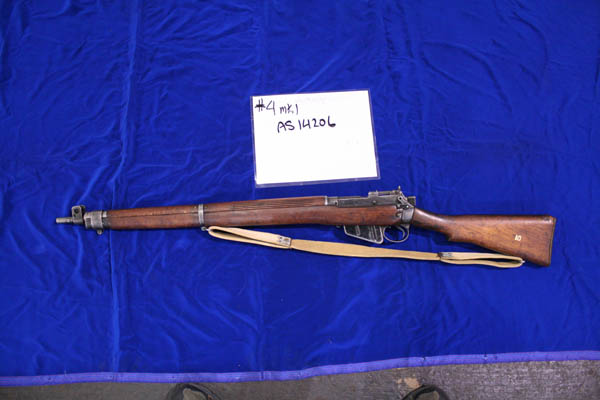Husky Guns
Canadian Lee-Enfied No. 4 Mk.1
Canada’s Army had used the Lee-Enfield rifle since the First World War. The No.4 Mk.1 pattern rifle replaced the No. 1 Mk. III* pattern rifle in the early 1940s. By the time of the Sicily campaign the Canadians were fielding the newer model No. 4s. These rifles were noted for their relatively high magazine capacity and the ability to cycle the action quickly.
This example was produced at the Long Branch arsenal in what is now Toronto, Ontario. It is chambered in the standard Commonwealth rifle and machine gun cartridge: .303 British. It has a 10 round detachable box magazine and utilises a bolt action.
Bren
The Bren gun was the standard light machine gun of the Commonwealth forces in the European theatre. It was a refinement of the Czech ZB-26 machine gun. The name Bren is a combination of the Czech factory BRNO and Enfield. The Bren used a top feeding magazine which required the use of offset sights. It was rugged and reliable gun which was well liked by the troops.
This example was made in the Inglis factory in Ontario. The Inglis factory produced the majority of the Brens used by Commonwealth forces during World War Two. The Bren is chambered in .303 British and is fed by 30 round detachable magazines. It has a rate of fire of 500 rounds per minute.
Enfield No.2 Mk. 1
The Enfield revolver was a scaled down version of the famous Webley service revolver from the First World War. It was mainly issued to Officers, tank and armoured vehicle crews, as well as pilots. The Enfield is a top-break double-action revolver chambered in .38 S&W. It used a 6 round cylinder.
PIAT
The PIAT was the standard Commonwealth anti-tank weapon during the later part of the European campaign. Unlike other ranged anti-tank weapons employed by the Axis or Americans, the PIAT was not a rocket launcher. It used a compressed spring to launch a HEAT projectile to an effective range of roughly 100m. The spring operated system presented some advantages in that it did not leave any muzzle blast to indicate the firing position, however the weapon was heavy and difficult to initially load. It also had heavy recoil. It was operated by two man teams but could be operated by one person.
German Kar98k
The Mauser Kar98k was the main arm of the German army’s soldiers throughout the Second World War. Developed as a more compact and handy version of the longer Gewehr 98 from the First World War, this rifle served on all fronts. This example was made by Mauser at its facilities at Oberndorf in 1937. It is chambered in the standard German rifle and machine gun cartridge: 8mm Mauser (7.92x57mm). It has a 5 round internal magazine and uses a bolt action.
MP40
The MP40 was the standard Submachinegun of the German army during the Second World War. A refinement of the MP38, it utilised more stamped instead of machined parts in order to ease production. It is noted for being accurate and having low recoil. It uses a folding stock which folds under the gun. It fires from the open bolt and is fully automatic only, with no provision for single or burst fire. The MP40 used a 30 round detachable box magazine and was chambered in the 9mm Luger cartridge. This example was made in 1942 by Steyr-Daimler-Puch. At this time Steyr was using slave labour from the Mauthausen concentration camp system to produce weapons for the German Wehrmacht and Waffen-SS.
MG34
The MG34 was the standard German machine gun throughout the war. A well designed general purpose machine gun, its main drawback was that it was costly to produce. It was never completely replaced by the easier to manufacture MG42, however, and was produced until the end of the war. The gun carried an integral bipod for deployment in the light machinegun role, or could be installed onto a Lafette tripod and used in the heavy machinegun role.
This example was manufactured in the occupied Czech factory at Brunn in 1944, one of the prewar Czech BRNO factories. The MG34 was capable of single shot, and adjustable automatic fire from 600-900 rounds per minute. It used either a 50 round assault drum or 250 round belts of ammunition. It is chambered in 8mm Mauser (7.92x57mm).
P08 Luger
Probably the most famous German handgun, the P08 Luger served as a standard sidearm for the German army from the First World War into the Second. Production ceased in 1942 and efforts were concentrated on the P38, solely due to the complexity of the P08’s manufacture. It uses a unique toggle action and is chambered in the 9mm Luger cartridge. It is fed by 8 round magazines. This example was manufactured in 1917 by the Erfurt arsenal.
P38
In the 1930s the Germans recognized the need to replace the P08 with design that was easier to manufacture. Walther designed the P38 pistol which incorporated many stamped parts which were easier to produce than the P08’s all machined parts. The P38 shared the same caliber, 9mm Luger, and also used an 8 round magazine.
This example was made by Spreewerk which had facilities in Germany and Czechoslovakia.
Italian Breda M37
The Breda M37 was the Italian heavy machine gun during the Second World War. It utilised an inefficient 20 round pan magazine that was fed through the side of the gun. It was chambered in 8x59mm Breda and was capable of a maximum of 460 rounds per minute.
Beretta M1934
The Beretta M1934 was the standard sidearm of the Italian military during the Second World War. The unique open slide design cut down weight is still seen on modern Beretta pistol designs. The pistol is chambered in 9mm Corto (.380 Auto) and utilises a 7 round detachable magazine.
This example bears the “RE” proof indicating it was issued to the Army. “RM” would indicate Naval issue, and “RA” would indicate Air Force issue.











